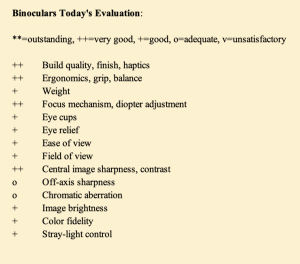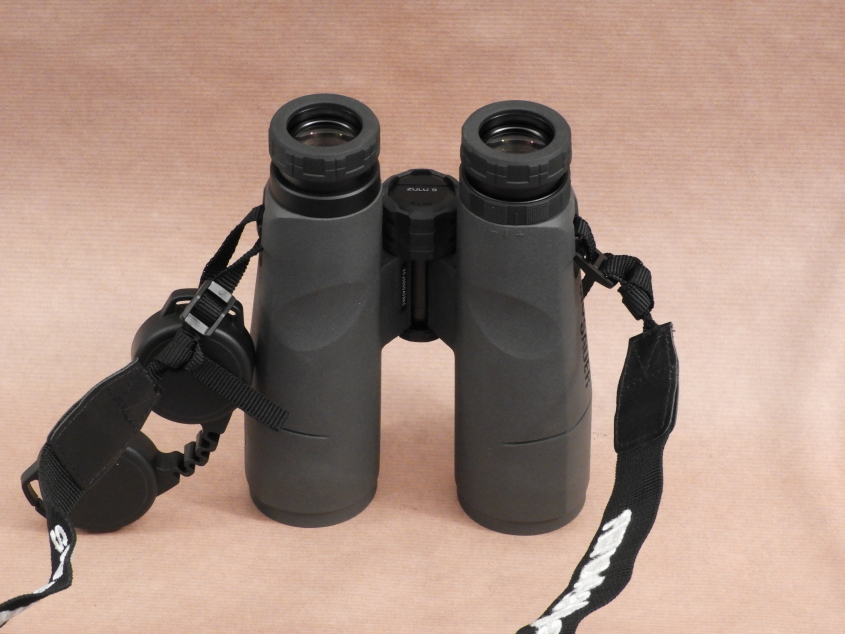SIG SAUER Zulu 9 9×45
Specifications:
Objective diameter: 45 mm
Magnification: 9x
Exit pupil: 5 mm
Eye relief acc. to spec: 17 mm
Usable eye relief (measured from rim of eyecup): 15.5 mm
IPD: 56 – 74 mm
RFOV: 7.2 degrees = 126 m / 1000m
AFOV (measured, rounded): 61.5 degrees
Minimum focus distance (measured): 1.3 m
Focus type: CF (direction of rotation from close to infinity: > clockwise)
Degrees of rotation of focus wheel from 3m to infinity (measured): 175 degrees
Range of diopter adjustment (acc. to spec.): +/- 3 dpt*
Excess travel of focus wheel beyond infinity position (estimate): 6 dpt*
True aperture: 45 mm (measured)
Prism type: Abbe-König
Waterproof: yes
Weight (measured, with eyepiece cover and strap): 1086 g
Made in: Japan
Guarantee period: unlimited, fully transferrable
*range of diopter adjustment not affected by position of focus wheel


Remarks:
Heavy, robust binocular in a tough looking military / hunting/ futuristic type of design (designed by someone who had been watching too many episodes of Star Wars ?) with excellent mechanical and overall quite good optical performance. See more detailed review below.
Comparing some mechanical parts and in particular the inside of the tubes with the baffles etc., it appears that the Zulu is built at the same factory that also builds some of the Maven binoculars; however, performance characteristics are different, e.g. edge sharpness is much better in the Maven B2 which is comparable to the Zulu, see separate post, https://binocular.ch/maven-b2-11×45/
It appears that in August of 2023, the ZULU 9 line was replaced by a new ZULU 10 HDX line, with three models: 10×42, 12×50 and 15×56. So in fall of 2023, SIG offers eight different “ZULU HDX ” models: three 10 HDX models (just mentioned), plus a ZULU 8 HDX 10×42, and four stabilized ZULU 6 HDX models: 10×30, 12×42, 16×42, and 20×42.
Ratings:

Review:
Designed by SIG Sauer Electro-Optics, Portland, Oregon
Made/Assembled in Japan (by Kamakura?)
The Zulu 9 line of products consists of 2 models: 9×45, 11×45. Reviewed hereafter is the 9×45 model.
—–
Excellent finish, the armour fits the binocular body perfectly; the grip is very good, dry or wet. The binocular appears rather heavy, but is well balanced.
Mechanics:
Impeccable – bridge, eyecups (positions: fully in / 2 distinct intermediate click stops / fully out), central focusing (smooth, precise), dpt. adjustment on right eyepiece – everything makes a solid, precise and extremely robust impression.
Optics:
Nice round exit pupils, no false pupils and almost perfectly dark areas around the EP; some vignetting but quite within limits.
Ease of view (“Einblickverhalten”) good. Collimation / alignment good. The field of view is with 7.2 degrees not overwhelming, but decent.
Excellent central sharpness and contrast, nice bright image. Off-axis sharpness is a bit disappointing, it deteriorates from about 60% outwards towards the edge of the image.
There is quite a bit of rectilinear distortion, but (consequently) very little globe effect; nice, easy and relaxed panning.
There is also quite a bit of field curvature. This is clearly NOT a flat field binocular.
Stray-light suppression appears very good, almost no veiling glare, very little reflections. Almost no spikes.
CA: there is quite a bit of CA, even at the center of the image, further out it is even more pronounced. Comparing the Zulu to other “subprime” binos with ED glass, e.g. the Vortex Razor 8×42 and the Kowa Genesis 8.5×44: the Kowa shows much less CA, and also the Razor shows less.
Color fidelity (paper test acc. to W. Schön) is good. Natural colors in field use.
Preliminary conclusion:
This is an expensive bino, but it’s overall optical and mechanical performance is quite qood. The image is bright and despite clearly visible CA quite sharp and rich in contrast; edge sharpness could clearly be better. Flat-field enthusiasts and people sensitive to CA might not get happy with the Zulu.
The Maven B2 also comes in the two configurations 9×45 and 11×45; their shape (apart form armour) and weight is similar to the Zulus, their length is identical, and some of the specs, e.g. eye relief, field of view etc. appear the same. Are they in essence the same binos ?




Leave a Reply
Want to join the discussion?Feel free to contribute!